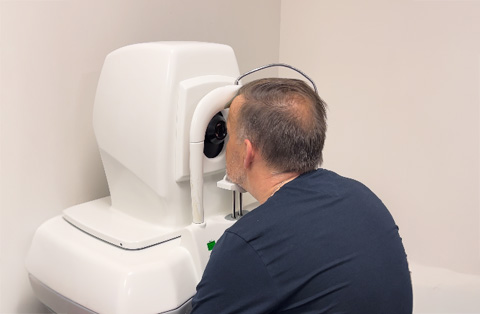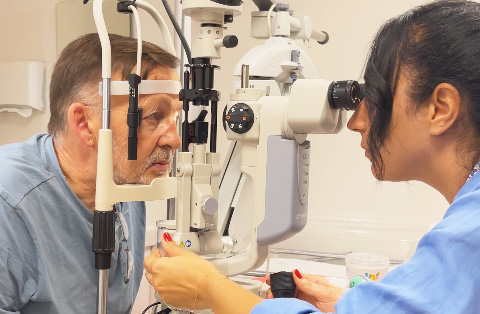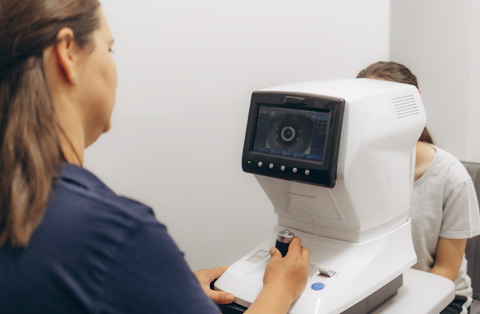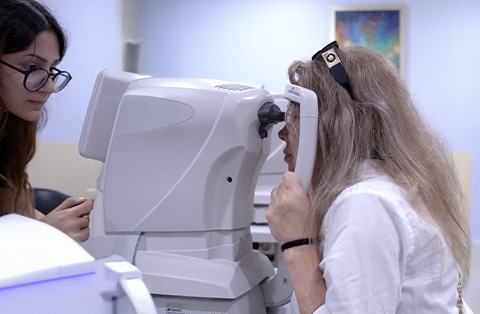Clear vision without glasses or flap-related risks: SMILE laser eye surgery offers a safe, precise, and minimally invasive solution for myopia and astigmatism with fast recovery and long-term stability.
What is SMILE Laser Eye Surgery?
SMILE Laser Eye Surgery stands for Small Incision Lenticule Extraction. It is a minimally invasive laser vision correction technique. It reshapes the cornea to correct refractive errors such as myopia (nearsightedness) and astigmatism.
Unlike traditional LASIK, SMILE does not require a corneal flap. Instead, a femtosecond laser creates a small, lens-shaped piece of tissue (called a lenticule) inside the cornea. The surgeon removes this lenticule through a tiny incision. This change in shape improves how light focuses on the retina, restoring clearer vision.
SMILE is known for its gentle approach. It preserves more of the cornea's natural structure and nerve endings. This can reduce the risk of dry eye after surgery and improve long-term corneal stability.
It is FDA-approved and used in many countries. It has quickly become a preferred option for suitable candidates.
What is ReLEx SMILE Surgery?
ReLEx SMILE stands for Refractive Lenticule Extraction – Small Incision Lenticule Extraction. It is the full medical term for what is commonly called SMILE laser eye surgery. This is the most advanced form of laser vision correction available today.
ReLEx SMILE combines the precision of femtosecond laser technology with a minimally invasive surgical approach. Unlike LASIK, which uses two types of lasers and creates a flap, ReLEx SMILE is done with a single femtosecond laser and does not involve a flap.
The laser creates a small, lens-shaped tissue (lenticule) within the cornea. This lenticule is then removed through a very small incision, just a few millimeters wide. Removing the lenticule reshapes the cornea and corrects the refractive error.
This method improves safety, comfort, and long-term corneal stability. It is used to treat myopia and astigmatism with high accuracy and fewer side effects.
SMILE vs LASIK: Key Differences in These Laser Eye Surgery Types
SMILE and LASIK are both effective laser eye surgeries to correct refractive errors. However, they differ in how they reshape the cornea and in their surgical techniques.
Surgical Method
LASIK creates a flap in the cornea using a microkeratome or femtosecond laser. The surgeon then lifts this flap and reshapes the underlying corneal tissue with an excimer laser.
SMILE uses only a femtosecond laser. It creates a small lenticule within the cornea, which the surgeon removes through a 2–4 mm incision. There is no flap in SMILE.
Corneal Stability
SMILE preserves more of the upper corneal layers and nerve fibers. This may lead to better biomechanical stability in the long term. LASIK, by creating a flap, can affect more of the cornea's structure.
Dry Eye Risk
LASIK may cause more temporary dry eye symptoms due to nerve disruption from the flap. SMILE has a lower risk of dry eye because it leaves more nerves intact.
Recovery and Discomfort
Both offer fast visual recovery. However, some patients report less discomfort and light sensitivity after SMILE. LASIK patients may recover slightly quicker in the first few days.
Suitability
LASIK treats a wider range of vision problems, including hyperopia. SMILE is currently approved for myopia and astigmatism, with ongoing studies expanding its use.
Both procedures are safe and effective. The choice depends on eye structure, lifestyle, and medical suitability.
The Evolution of Refractive Surgery: From LASIK Eye Surgery to SMILE Vision Correction
Refractive surgery has evolved over decades to improve vision correction and reduce side effects. Each step has focused on safety, precision, and patient comfort.
PRK (Photorefractive Keratectomy) was the first generation of laser eye surgery. Surgeons removed the surface layer of the cornea to reshape it with an excimer laser. PRK was effective but involved more discomfort and a longer recovery time.
LASIK (Laser-Assisted in Situ Keratomileusis) came next. It introduced a corneal flap, allowing faster healing and less discomfort. LASIK quickly became the most popular laser eye surgery. However, the flap introduced new risks like dry eye and flap-related complications.
SMILE (Small Incision Lenticule Extraction) represents the latest advancement. It removes the need for a flap. By using a femtosecond laser to create and extract a lenticule through a small incision, it combines precision with a more tissue-conserving approach.
SMILE keeps more of the cornea intact. This improves stability and reduces the risk of dry eye. It also minimizes the chance of flap-related issues.
The evolution from PRK to LASIK to SMILE shows a clear trend: less invasive methods with better outcomes and fewer complications. Each new technique builds on the success of the previous one, with SMILE offering the most modern approach to laser vision correction today.
What Are the Benefits of SMILE Eye Surgery Procedure?
SMILE eye surgery offers several important benefits for patients who are suitable candidates. It is a modern, minimally invasive procedure with advantages that go beyond vision correction.
No Corneal Flap
SMILE does not involve creating a corneal flap. This lowers the risk of flap-related complications like dislocation or infection. It also preserves more of the eye's natural strength.
Lower Risk of Dry Eye
Because the incision is much smaller and fewer corneal nerves are affected, patients often experience fewer dry eye symptoms after SMILE compared to LASIK.
Faster Healing of Corneal Tissue
The small incision allows the cornea to heal more quickly. Most patients return to daily activities within a few days.
High Precision with a Single Laser
SMILE uses only a femtosecond laser, which offers high accuracy in tissue cutting. This reduces the margin for error during the procedure.
Better Corneal Stability
The procedure preserves the upper layers of the cornea, which helps maintain structural integrity. This is especially important for patients with thin corneas or active lifestyles.
Less Light Sensitivity
Many patients report reduced sensitivity to bright light during the early recovery phase compared to LASIK.
SMILE is especially beneficial for individuals with moderate to high myopia and astigmatism. It is a safe, effective option for long-term visual correction.
How Much Does SMILE Laser Eye Surgery Cost?
The cost of SMILE laser eye surgery varies significantly across countries, influenced by factors such as clinic reputation, surgeon expertise, and included services.
United States
In the U.S., the average cost of SMILE surgery ranges from $2,000 to $4,000 per eye. This price typically includes pre-operative evaluations and post-operative care. The higher costs are attributed to advanced technology, surgeon experience, and comprehensive patient care.
United Kingdom
In the UK, SMILE surgery costs approximately £2,150 to £3,100 per eye. Prices vary based on the clinic's location, the surgeon's experience, and the technology used.
Western Europe
In countries like Germany, the average cost of SMILE surgery ranges from $2,843 to $6,250. These prices often exclude additional services such as accommodation or transfers.
Türkiye
Türkiye offers SMILE surgery at a more affordable rate, with prices ranging from $1,250 to $2,750. Despite the lower cost, patients receive high-quality care from internationally trained surgeons using advanced technology. Many clinics also provide comprehensive packages that include accommodation and transfers.
Türkiye's combination of affordability and high medical standards has made it a popular destination for SMILE laser eye surgery.
Is SMILE Eye Surgery Covered by Insurance?
In most cases, SMILE eye surgery is not covered by health insurance. This is because it is considered an elective procedure. Insurance companies classify it as a vision correction surgery, not a medical necessity.
However, there are exceptions. Some insurance plans may offer partial reimbursement or discounts through affiliated eye care providers.
What is the Recovery Process for SMILE Laser Eye Treatment?
The recovery process after SMILE laser eye surgery is usually smooth and fast for most patients. Because the procedure involves a small incision and no corneal flap, healing tends to be more comfortable than with older methods.
First 24 Hours
Most patients notice improved vision within a few hours. Blurred vision, mild discomfort, and light sensitivity are common at first. These symptoms usually ease by the next day.
First Week
Vision continues to improve. Most people return to work and daily activities within 1–2 days. The small incision heals quickly, and there are no stitches. Eye drops are prescribed to prevent infection and support healing.
First Month
Vision stabilizes further. Any dryness or mild fluctuations in clarity tend to improve. Follow-up visits check healing and ensure the eyes are responding well.
After 1–3 Months
Final visual results are typically achieved. Patients enjoy sharp, stable vision with minimal side effects. Long-term follow-up may include periodic eye exams to monitor eye health.
SMILE has a shorter recovery time and fewer post-op restrictions compared to LASIK. Most patients resume normal life quickly with excellent results.
Who Are Good Candidates for SMILE Eye Surgery?
SMILE eye surgery is a safe and effective option for many people. However, not everyone is a suitable candidate. An eye examination is essential to confirm eligibility.
Good candidates usually include:
Adults over 18 with stable vision for at least one year
People with mild to high myopia (up to -10.00 diopters)
Individuals with up to -5.00 diopters of astigmatism
Those with healthy corneas and adequate corneal thickness
Patients not suitable for LASIK due to thin corneas
People with active lifestyles who want to avoid flap-related risks
People not eligible may include:
Individuals with hyperopia (farsightedness), as SMILE does not currently treat it
Those with keratoconus or irregular corneas
Patients with severe dry eye or corneal disease
Pregnant or breastfeeding women
Anyone with uncontrolled autoimmune or eye conditions
A detailed pre-operative evaluation is the best way to determine if SMILE is right for you.
Eye Conditions That Can Be Treated with SMILE
SMILE laser eye surgery is designed to treat specific refractive errors. It works by reshaping the cornea to improve how light focuses on the retina. This results in clearer vision without the need for glasses or contact lenses.
Myopia (Nearsightedness)
SMILE is most commonly used to correct myopia. This condition causes distant objects to appear blurry. SMILE can treat a wide range of myopia, from mild to high levels, up to around -10.00 diopters.
Astigmatism
Astigmatism occurs when the cornea has an irregular shape, causing blurred or distorted vision at all distances. SMILE can effectively treat astigmatism up to -5.00 diopters. It reshapes the cornea more evenly, improving clarity.
Mixed Myopic Astigmatism
This is a combination of nearsightedness and astigmatism. SMILE can address both components in a single procedure, offering a comprehensive correction.
Currently, SMILE is not approved for treating hyperopia (farsightedness) or presbyopia (age-related difficulty focusing on near objects). However, research is ongoing, and future advancements may expand its use.
For suitable conditions, SMILE offers a long-term solution with precise, stable outcomes.
How is the SMILE Procedure Performed?
The SMILE procedure is performed using advanced femtosecond laser technology. It is quick, gentle, and minimally invasive. Here is a step-by-step explanation:
Step 1: Preparation
The eye is numbed with special drops. A device keeps the eyelids open. The patient remains awake but feels no pain.
Step 2: Laser Application
The surgeon uses a femtosecond laser to create a small disc-shaped piece of tissue (called a lenticule) inside the cornea. At the same time, the laser makes a tiny incision of about 2–4 mm on the surface of the cornea.
Step 3: Lenticule Removal
Through the small incision, the surgeon carefully removes the lenticule. This step changes the shape of the cornea, allowing light to focus properly on the retina.
Step 4: Healing
The small incision heals on its own without stitches. Because there is no flap, the healing process is more stable and faster.
The entire procedure usually takes less than 10 minutes per eye. Most patients notice clearer vision within a few hours and can return to daily activities within a couple of days.




